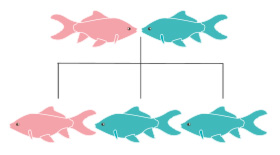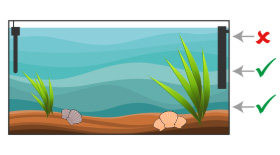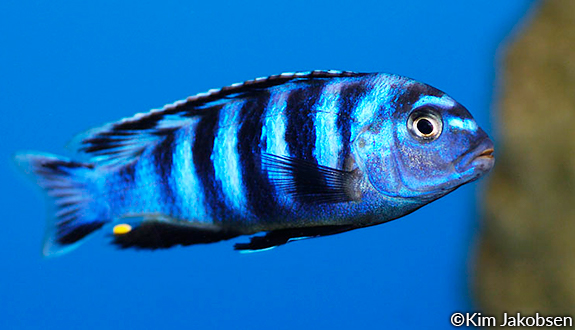

Alternative species (click on the thumbnail to see the card)
None
Names
Scientific name
Chindongo saulosi
Pseudotropheus saulosi (formerly)
Pseudotropheus sp. Taiwan Reef
Common name
Saulosi Mbuna
Origin

Origin: Lake Malawi (Taiwan Reef)
Biotope: African
Dimorphism

Very easy. The males are blue with black stripes and the females are yellow (cf "Good To know")
Group

Cichlidae
Volume

300 L / 66 Imp gal / 79 US gal
Parameters

T°: 25 to 26°C or 77 to 79°F
pH: 7.5 to 8.5
Hardness: 10 to 15°dGH
Difficulty

Easy
Size

8 to 9cm (3.2 to 3.6")
Longevity

5 to 6 years
Living zone

Middle and depth
Individuals

1 male + 2 female
Food
How to feed the Chindongo saulosi?
Food
How to feed the Chindongo saulosi?
It is a herbivorous fish with an algivorous tendency that grazes on plants fixed on rocks. It is easy to feed and you can distribute dehydrated food such as granules or flakes for vegetarian fish. Spirulina and spinach are also highly recommended. Vary the meals by also offering artemia, krill, fish meat, shrimps and cooked mussels.
Behavior
What kind of behavior does the Chindongo saulosi have?
Behavior
What kind of behavior does the Chindongo saulosi have?
Generally speaking, it is a lively fish with character. This is especially true during the breeding season when it vigorously hunts intruders out of its territory. The females are sociable and calm. The males on the other hand defend their territory but in large aquariums, their cohabitation is possible.
He digs the ground and arranges the decor to his taste: the Saulosi is at home!
Cohabitation
Who can live with the Chindongo saulosi?
Cohabitation
Who can live with the Chindongo saulosi?
The Chindongo should be kept in groups, in the form of harem (count 1 male for 2 or 3 females). Small jousts can take place so that a hierarchy is established.
In general, it is not very aggressive with its neighbors. It is a little belligerent with territorial fish but very little with non-territorial species.
It can coexist with other m'bunas avoiding species whose coats are close to that of the Pseudotropheus. Avoid large territorial fish that can dominate or injure it. On the other hand, cohabitation with larger species quite peaceful is possible.
Breeding
How to breed the Chindongo saulosi?
Breeding
How to breed the Chindongo saulosi?
Recommended water parameters for breeding are a temperature of 25/26°C or 77/79°F and a pH of 8.
The male wishing to breed swims in front of the female and then he attracts her to the laying site (often a rock or a basin dug in the sand).
The female takes the eggs in her mouth (usually about 30), then the male fertilizes them. To do this, the couple takes the so-called "T" position in which the female sucks the male's seed into her mouth.
The female keeps the eggs and then the fry in her mouth for 3 weeks. She does not feed during this period and tends to isolate herself to be quiet. Do not worry, it is normal.
The young fish coming out of the mother's mouth are already 1 cm (0.4") long and are very easy to feed. They are the same color as the females, the blue coloration of the males appearing later. Sexing is therefore difficult until a certain age. You can leave them in the company of their parents who do not hunt them.

The breeding of this species being very easy, you could quickly be overwhelmed! Attention thus with the overpopulation.
Fry food: artemia nauplias.
Its aquarium
Which aquarium for the Chindongo saulosi?
Its aquarium
Which aquarium for the Chindongo saulosi?
The aquarium is close to the natural environment: it is composed mainly of rock and sand. Pay attention to the stability of your decor to avoid any rockslide: first put your stones (if necessary glue them) and then add the sand. Form hiding places among the stones and arrange them all the way up to the surface (this makes it easier to determine the male's territory).
Keeping plants in an aquarium in Saulosi is an illusion: he uproots them and nibbles them... In short, there will not be much left of it.
Good To know
Find all additional information!
Good To know
Find all additional information!
It is a very popular species in aquariums in the Lake Malawi biotope.
If black stripes appear abnormally on their body, it is because they are stressed.
Sensitive to variations in water parameters, acclimatization is a difficult time for this species. Make sure that it is very slow and gentle. After this moment, it is a rather robust fish.
Previously this species was named "Pseudotropheus" which changed to "Chindongo" in 2016.
In its natural environment, the Chindongo saulosi is evaluated as CR = Critical Danger of Extinction by the IUCN. In fact, its excessive fishing and its very restricted habitat have greatly reduced the population of this fish in the wild. What a pity when we think of its ease of reproduction! If you wish to acquire it, make sure that your fishes come from breeding and not from the collection in natural environment.
Beware of confusion with Chindongo demasoni. In this species, unlike Chindongo saulosi, males and females have the same coat. They also have less vertical stripes.
The difference between males and females is very marked:
Male

Female

Yours photos!
Comments
Sort by:
Please login to post comments

